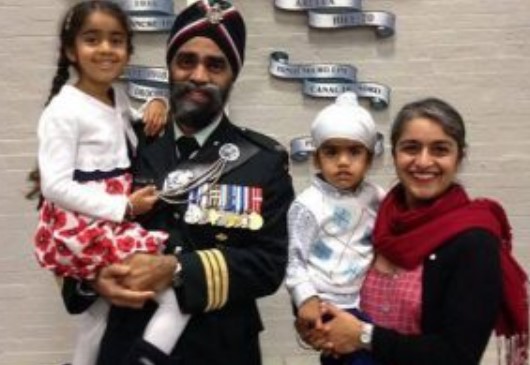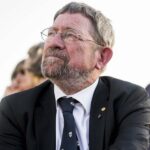Harjit Sajjan Age, Wife, Family, Biography
Quick Info→
Hometown: Bombeli, Punjab
Wife: Kuljit Sajjan
Age: 53 Years
| Bio/Wiki | |
|---|---|
| Full Name | Harjit Singh Sajjan |
| Profession | Politician |
| Physical Stats | |
| Height (approx.) | 5' 10" (177 cm) |
| Eye Colour | Black |
| Hair Colour | Salt & Pepper |
| Politics | |
| Political Party | Liberal |
| Political Journey | • 19 October 2015: Member of Parliament for Vancouver South • 12 February 2019-1 March 2019: Minister of Veterans Affairs • 4 November 2015-26 October 2021: Minister of National Defence • 26 October 2021-26 July 2023: Minister of International Development • 26 October 2021: Minister responsible for the Pacific Economic Development Agency of Canada • 26 July 2023: Minister of Emergency Preparedness • 26 July 2023: President of the King's Privy Council for Canada |
| Military Service | |
| Allegiance | Canada |
| Branch/service | Canadian Army |
| Years of service | 1989–2015 |
| Rank | Lieutenant-Colonel |
| Unit | The British Columbia Regiment |
| Commands | The British Columbia Regiment (Duke of Connaught's Own) |
| Battles/wars | • Bosnian War • War in Afghanistan • Operation Medusa |
| Awards | • Order of Military Merit • Meritorious Service Medal • Canadian Forces' Decoration • South-West Asia Service Medal • General Campaign Star • Commendation Medal • NATO Service Medal • Canadian Peacekeeping Service Medal |
| Police Service | |
| Department | Vancouver Police Department |
| Branch | Gang Crime Unit |
| Status | Retired |
| Rank | Detective |
| Personal Life | |
| Date of Birth | 6 September 1970 (Sunday) |
| Age (as of 2024) | 53 Years |
| Birthplace | Bombeli, Punjab, India |
| Zodiac sign | Virgo |
| Signature |  |
| Nationality | Canadian |
| Hometown | Bombeli, Punjab, India |
| School(s) | • Walter Moberly Elementary School, Vancouver, Canada • Sir Charles Tupper Secondary School, Vancouver, Canada |
| Religion | Sikhism |
| Controversies | Minister Reassigned After Service Record Controversy He was criticized by the House of Commons in 2021 for misleading Canadians about his service record and was later moved from Minister of National Defense to Minister of International Development. Criticized for his handling of sexual assault cases in the Canadian Armed Forces In 2018, Sajjan was informed of sexual assault allegations against General Jonathan Vance but did not take action. He was charged by the House of Commons in 2021 for his handling of the sexual misconduct issue. |
| Social Media | • Instagram |
| Relationships & More | |
| Marital Status | Married |
| Marriage Date | 30 June 1996 |
| Family | |
| Wife/Spouse | Kuljit Sajjan (physician) |
| Children | Son- Arjun Sajjan Daughter- Jeevut Sajjan  |
| Parents | Father- Kundan Singh Sajjan (a head constable with the Punjab Police in India) Mother- Vidya Kaur Sajjan  |
| Siblings | Sister- Manjeet Kaur |
Some Lesser Known Facts About Harjit Sajjan
- His father was a member of the board of the World Sikh Organization, a Sikh group.
- In 1976, Harjit Sajjan, his mother, and his older sister moved to Canada when he was five years old. His father, who had moved to British Columbia two years earlier, used to work at a sawmill.
- While settling in Canada, his mother worked on berry farms in BC’s Lower Mainland during the summer, often bringing Sajjan and his sister along.
- Harjit Sajjan grew up in South Vancouver.
- When he was 16 years old, Harjit realized he was hanging out with the wrong crowd, which included Bindi Johal, a notorious drug master and gangster who was killed in 1998. Harjit later helped arrest some of his former associates.
- He then got baptized (Amritdhari) as a Sikh to avoid bad company. Harjit was involved in many sports and athletic programs during his time in elementary and high school.
- In 1989, Harjit Sajjan joined The British Columbia Regiment (Duke of Connaught’s Own) as a trooper. In 1991, he became an officer. Later, he became a lieutenant colonel.
- Harjit Sajjan was deployed overseas four times; once to Bosnia and Herzegovina and three times to Afghanistan.
- In Bosnia, Harjit’s turban raised some concerns in certain Serb neighbourhoods, but he eased their worries by explaining that as a Sikh, he was likely the only neutral person in the Muslim/Christian conflict.
- After returning from Bosnia, Sajjan served the Vancouver Police Department for 11 years. His tenure ended as a detective in the gang crimes unit, specialising in drug trafficking and organized crime.
- Harjit Sajjan’s first posting to Afghanistan was just before Operation Medusa in 2006.
- He took leave from his job in the Vancouver Police Department’s gang squad for this appointment.
- Harjit Sajjan served with the 1st Battalion, Royal Canadian Regiment Battle Group in Kandahar. He also worked as a liaison officer with the Afghan police.
- During his stint in Afghanistan, he discovered that corruption in the Afghan government was increasing Taliban recruitment.
- Operation Medusa, which started on 2 September 2006, lasted 15 days and involved over 5,000 NATO troops. During the operation, four soldiers under Harjit’s command died, along with eight other Canadians and 14 British troops who died in a plane crash.
- After reporting his findings to Brigadier General David Fraser, Harjit Sajjan was asked to help Operation Medusa. Brigadier General Fraser praised Sajjan’s leadership during the operation as “nothing short of brilliant.”
- After that, Fraser wrote a letter to the Vancouver Police Department, calling Sajjan “the best single Canadian intelligence asset in theatre” and stating that his work saved “a multitude of coalition lives.”
- Fraser also advised the Canadian Forces to “seek Sajjan’s advice on how to change our entire tactical intelligence training and architecture.”
- During his stint in the police force, Harjit Sajjan was praised for his planned counterinsurgency knowledge in an important operation in September 2006.
- After returning to Vancouver, he left his police job. He started a consulting business where he began teaching intelligence-gathering techniques to Canadian and American military personnel.
- After that, Harjit Sajjan consulted Barnett Rubin, a US policy analyst and Afghanistan expert and discussed tackling the Afghan opium trade. Their collaboration involved advising American military and diplomatic leaders in Afghanistan.
- In 2009, he returned to Afghanistan for another tour, taking leave from the Vancouver Police Department.
- In 2010, Harjit Sajjan left the police department for his third tour to Afghanistan, during which he was a special assistant to Major-General James L. Terry, the commander of American forces in Afghanistan.
- In 2011, he became the first Sikh to command a Canadian Army reserve regiment as commander of The British Columbia Regiment (Duke of Connaught’s Own).
- In the same year, Harjit was posted to Afghanistan as a special adviser to U.S. Lieutenant General James Terry, who was then the commander of NATO’s International Security Assistance Force joint command in Afghanistan.
- In 2012, Harjit Sajjan received the Meritorious Service Medal for reducing the Taliban’s influence in Kandahar Province in Afghanistan.
- In 1996, he invented and patented a gas mask for his face and beard due to his Sikh beliefs requiring facial hair.
- In the 2015 federal election, Harjit Sajjan was elected as a Member of Parliament for Vancouver South after defeating his rival Wai Young of the Conservative party.
- On 4 November 2015, he was appointed as a minister of national defence in Justin Trudeau’s Cabinet.
- In February 2019, Harjit Sajjan briefly served as acting minister of veterans affairs after the resignation of Jody Wilson-Raybould. Later, Lawrence MacAulay was appointed to the position.
- His alleged ties to the Khalistan movement led to diplomatic tensions with Amarinder Singh, the former Chief Minister of Punjab.
- In September 2019, Harjit Sajjan attended an event celebrating the 70th anniversary of China’s founding, which drew criticism from the Conservatives.
- In April 2017, he claimed in a speech that he was “the architect” of Operation Medusa, a major Canadian military offensive in 2006 against the Taliban. He made similar claims in 2015, saying that General Jonathan Vance saw him as crucial to the operation. However, Sajjan was a major in the Canadian Army reserves during Medusa, and some military officers called his claim false.
- Later, Canadian historian Jack Granatstein acknowledged Sajjan’s role in providing intelligence for the operation but said he was not the chief planner. British officer Christopher Vernon and Brigadier General David Fraser emphasized Sajjan’s vital role in the operation. Harjit Sajjan later apologized for claiming to be the “architect” and recognized Brigadier-General David Fraser’s leadership.
- In 2018, during a visit to India for the Asia launch of a global campaign, Harjit mentioned that he faced discrimination in the military as he looked different. Harjit Sajjan said,
I was born in India and moved to Canada, when I was five… When I was 18 and joined the military there, I faced discrimination, even though I am a Canadian…because I looked different.”
- In 2024, The Globe and Mail reported that Sajjan instructed Canadian special forces to rescue 225 Afghan Sikhs during the 2021 Kabul evacuation. Military sources accused him of misusing resources that could have been used to evacuate Canadian citizens.
- However, Sajjan claimed that he only passed the information. General Wayne Eyre stated that the military followed legal orders. Later, critics appealed for an investigation, and The Globe and Mail’s editorial board criticized Sajjan for compromising the evacuation.
- In 2024, The Globe and Mail reported that Harjit Sajjan, as Minister of International Development, requested 100 soldiers to serve as backdrops for a concert by Punjabi musician Diljit Dosanjh. Later, the Canadian Forces refused, but Sajjan’s spokesman supported the request, highlighting Dosanjh’s popularity.
- Harjit Sajjan likes travelling to distant places in his free time.
- He often participates in marathons organised in Canada.
- He has been a regular advocate for education and mentorship programs that encourage young people to be more active in society, helping them avoid falling into gangs and drugs.
- Harjit Sajjan is the first Sikh and the first South Asian, to lead a Canadian regiment as a commanding officer.


















